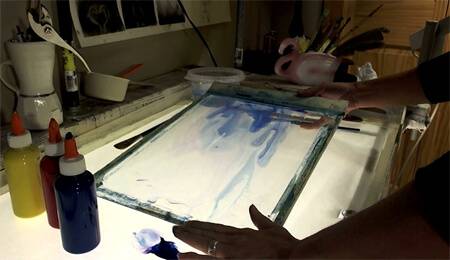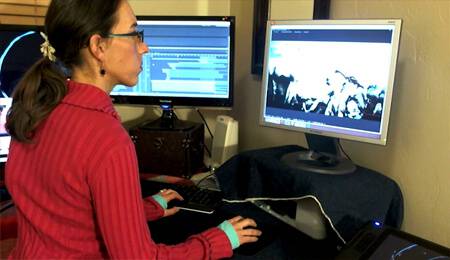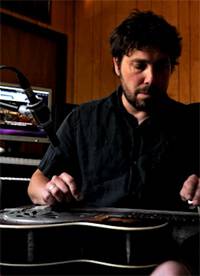Corrie Francis Parks on ‘A Tangled Tale’
Montana-based Corrie Francis Parks has been working as a freelance animator, independent director and photographer for over a decade. With a background in traditional animation and fine art, she eventually discovered an affinity with the process of sand animation and the ways it can be combined with modern, digital processes. Her latest short A Tangled Tale, in which two fish find themselves entwined against their will, is a charming tale of duality and interdependence that came to be after a successful Kickstarter campaign in 2011. Following a highly successful festival run including screenings at Annecy and Hamburg, the short has been released online in full to mark the two year anniversary of reaching her Kickstarter goal. Skwigly caught up with Corrie to discuss the production of her first crowdfunded venture.
Crowdfunding seems to be far more prevalent nowadays. From your perspective has the public’s attitude toward Kickstarter changed much in the last two years?
I definitely agree it has become ubiquitous now. Two years ago when I was doing it, the majority of the people I had sent it to – parents, friends, my Grandmother, even just people of the older generation encountering it for the first time – I had to explain it to. Now my Mom is like “Oh yeah, I’ve seen so many Kickstarter projects recently”, she knows all about it! So I think that it has become a very recognised form, it’s been written up by every major newspaper and whatnot.
“I get at least one or two pleas for Kickstarter support every week. I feel lucky because I think that I did it at the right time, just as it was ramping up and becoming this really cool thing. I think if I did another Kickstarter now I would have to approach it very differently because there is an overload of projects. Now the challenge is how to make yours stand out as something that you want people to support you on, where people will jump on board. You can’t support every Kickstarter that comes into your inbox anymore, so you have to be a lot more selective and choosy and look at it like “Well, what am I gonna get out of this? Is this a project I really believe in?” before you click that ‘back’ button.
When did you get into sand animation and how long have you been working in it?
I made my first sand film in 2003, that was in grad school, really just as an exercise in this experimental animation class. I really gravitated toward the techniques and I like working in it but we were shooting everything in 16mm at the time, so there’s a lot of limitations when you don’t have digital fanciness to apply to it. At that point I’d made this little film called Tracks and figured out how to add some neat colour with theater gels to do something different with the sand. I was really pleased with it but told myself I’d never work using this technique again, it’s so much work and it all looked the same and I was more interested in drawing. I didn’t get back to it until 2007 when I had a commission for a Disney theme park where they wanted some sand animation. At that point I was shooting everything digitally and realised there was so much I can do with it now that I had digital frames and could composite stuff, change colours, add different backgrounds, do awesome camera movements and things like that. So that’s when I really started to make it my technique, and I’ve made a couple little commercial projects with it and another short film before A Tangled Tale. I’m really pleased with the results.

The combination of digital and traditional processes is used to quite impressive effect. Were the backgrounds themselves hand-painted?
Yeah, it was a combination of hand-painted watercolour elements, which I then layered together with some live-action footage of paint flowing down glass. My whole goal was to create this underwater environment that had some depth but that blended really well with the sand texture and didn’t necessarily look composited in. The whole point of the film was that I didn’t want it to be obvious – what’s composited, what’s done on separate layers – I wanted it to be one entire world. So I used a variety of those elements and then also had some sand layers in there to add more of that murky, underwater texture where the plants were all animated separately as well. So squishing all of that in with After Effects took a lot of tweaking to get just right, and then also adding the fish animation and keeping the colour of the fish from getting lost in the background. One of the things that I really like about the technique that I’m developing is this hand-tinting aspect, where I shoot all of the frames in black and white, then take each individual frame and actually hand-tint it in Photoshop with a watercolour brush. That I think really adds this vibrance to the sand that you can’t get any other way.
Although it is clearly an animation it does have a sense of the real about it, when it came to the animation itself did you refer to much by way of reference footage or just go with your gut?
I did look at a lot of underwater videos and just took note of what it was that I liked. The whole thing with animation is you’re trying to create the illusion of life, – that is, not representing life exactly but pulling out the little elements that, when you exaggerate them just a little bit, ring true in an artistic context. So I was looking at footage of fish swimming down river beds and how light plays under the water as points of inspiration for what I could then translate into the sand animation.

Given the organic nature of sequential animation when working with sand (or indeed any form of stop-motion) did you outline each sequence of events beforehand or was there room for improvisation?
I definitely planned some stuff out and did some hand-drawn reference footage for some of the more complex movements, when I was trying to time how the two fish would interact with each other in certain scenes. So I actually drew out some thumbnail sketches and used that as reference when I was shooting the animation, but that is the wonderful thing about working straight-ahead and with sand is that it’s very improvisational, the sand sometimes just wants to go in the direction it wants to go, whether or not I want it to. Sometimes you just have to follow that. I especially try to leave the more abstract sequences completely open so that I can just play with the texture and the formation of the sand, because I feel like it’s really in between sculpture and drawing. It’s a three-dimensional medium but you’re working in a two-dimensional plane, so I like that whole hybridization of feeling the dimension of the sand but then kind of pushing it into that 2D world.
For the film’s premise, it builds on a rather crucial image of the fish tangled together in the fishing line, did the film begin with that image or was there an overall concept/theme that you had in mind for a film that came first?
It definitely came from that image, most of my films usually come from one strong image that pops into my head and just doesn’t go away, so for me it was that image of these two fish entangled on a fishing line, not really sure if they wanted to be together or apart. It’s definitely about the complexity of romance and relationships, the fact that it’s not always a happy, rosey world, being with the one that you want to be with. Or maybe you don’t even know if it’s the one you want to be with, or it’s just that fate has brought you together and pushed you and you can’t escape – I think that those ideas were kind of all bouncing around in my head from a relationship I was in at the time, that manifested itself into this very strong image of these two fish in this dire situation. From there, working with the sand and experimenting, the rest of the story built around that.
Are there any particular pioneers or contemporary animators working in sand – or possibly just as filmmakers/storytellers – that you feel you’ve been personally inspired by?
I’ve wanted to be an animator since I was thirteen and I’ve been on this straight shot towards animation since I was a teenager. It was animators like Norman McClaren, Ishu Patel, Caroline Leaf, all of these people exploring these amazing techniques, that were the first to really blow my mind about animation; Watching all that work and how they’d take materials and make their materials an integral part of the storytelling process. I think Caroline Leaf does that extremely well, so she’s definitely been one animator that I’ve always looked towards as inspiration, and there’ve certainly been others.
I always like to ask directors about the role of music in their films, especially when it’s such a key part of the overall soundscape as with A Tangled Tale. How did you find working with your composer for the film, I’d imagine you were quite involved?

Composer Mark Orton
Oh, it was awesome. Again, going back to that whole Kickstarter thing of having a budget and being able to pay someone, the composer Mark Orton is fantastic. He works as part of an ensemble called Tin Hat and he’s also been doing a lot of film work. He just composed a score for the feature film Nebraska which is getting a lot of press here in the States. I sent him the storyboard for A Tangled Tale while I was raising money, just because I’d been familiar with his work in Tin Hat, and asked him if he’d be interested in it. He called me back right away and said “Yes definitely, I really like the story”. That’s always a good sign, when your composer is really excited about the work before it’s even finished! After I had the picture locked I went out to Portland where he’s based and sat down with him for almost a week. We went through the film scene-by-scene, discussed the tone and what I was trying to communicate. Because the story in the film is fairly subtle and the emotional arcs are very important, they’re dependent a lot on having that music to help the audience along through the film. He just honed right in on that and was able to shape the score around those beats. He also has the most incredible library of weird and unusal instruments and sounds; Some of the cool sounds in the score come from a water drum, or taking the wheel of a bicycle and playing it with a violin bow, there’s all sorts of crazy instruments that he has in his studio, it’s really cool. So it was great working with Mark, he did an excellent job and I hope that I’ll be able to work with him again on future films.
Do you find that commercial work and personal work make good bedfellows or do they ever get in the way of each other?
I think that it depends on how you approach it. There are some projects that I have gotten recently that have had a lot of flexibility and allowed me to continue exploring sand in the context of a commissioned work. I just did a book trailer recently for a friend where I was able to take that and think “Well this is mostly gonna be hand-drawn, how can I incorporate some of the texture of sand into this?” And that really challenges me as an artist, to think outside the one particular way I do sand and I think that’s what keeps me moving forward. The thing about having commissioned work is usually when there’s somebody paying you, you have to make that a priority, so the more commissioned work I get, obviously the less time I have to spend on my own experimenting. So far it’s been a good balance for me and also has given me a lot of flexibility because I have a lot of creative control over the works that I do, simply because that’s why people come to me is they want my style and my particular vision of animation, rather than just anything that can be thrown together in After Effects.
How did your involvement in the book trailer come about?
Kelly Luce – the author of this collection of short stories set in Japan – and I met at the MacDowell Colony, which is an artist residency in New Hampshire. While we were there at the beginning of December, there was this huge ice storm that shut down the Northeast for a week. The few of us that didn’t try to escape and go home had no power for a week. So Kelly and I became good friends through this dire situation of having to make our fires to keep warm and trying to do our work while the power was out. I’ve always admired her work and always wanted to collaborate with her, so when she told me that she was releasing her first collection Three Scenarios in Which Hana Sasaki Grows a Tail I immediately said “I’ll do your book trailer for you!” It ended up being a really great project and I hope that it might turn into something more, because some of the stories would be fantastic as animated short films, so we’re talking about that right now. But for now the trailer’s a really fun little piece of work in itself.
Would the potential short films be in the same sort of art style, do you think?
It would probably be similar, although I would like to work the sand in a little bit more. With the production schedule that we had I didn’t have time to really hone in on how to blend the sand in a way that I would have liked to. As my background is originally traditional character animation and fine arts I’d like to bring that more into sand animation, so that they become more of a hybrid.
Are there any other current or upcoming projects you can discuss?
One thing that I do want to do in the next year is start experimenting with different materials, maybe different types of sand, because I’ve always used the same beach sand from Venice Beach. Different sand has different textures, different qualities. A friend of mine is a sculptor who gave me this bag of marble dust left over from when he polishes his sculptures, so I wanna try animating that and see what that looks like because it’s a really fine, chalky dust that could look really cool.
For more information on A Tangled Tale you can visit the film’s website and Facebook page. Upcoming screenings include KLIK! Amsterdam, You can find out more about Corrie Francis Parks’s other projects at corriefrancis.com

